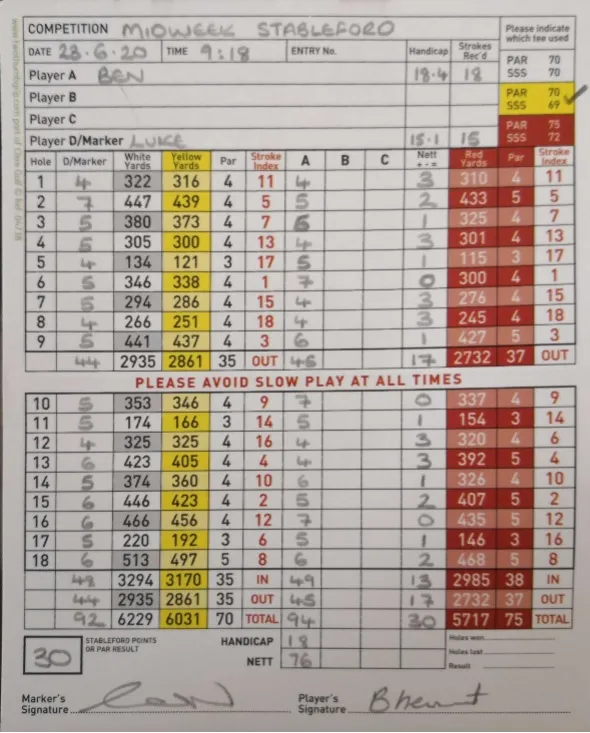Josh’s Tips & Tricks: Marking Scorecards
Intro
Hello golfers, welcome to this week’s tips & tricks. This week is aimed more towards those that haven’t been playing that long. My tips & tricks are usually drills or exercises that you can practice on the range but there are other important parts to the game of golf that aren’t about the golf swing. One thing that can be very daunting is the thought of playing your first competition and therefore marking a scorecard correctly. You can practice now through the winter months in your social golf so you’re ready for tournament time in the spring.
Requirements
There are only a few things that are actually required to ensure your scorecard is marked properly. If any of these are not filled in correctly you could possibly end up being disqualified.
The first thing that you need on there is your name. This should always be filled in next to “Player A”.
The next thing you need is your handicap. This is your “world handicap” index. This can then be adjusted accordingly for the course you’re playing.
You then need to swap cards with your playing partners. When the card is marked, the gross score of the player’s card you’re marking should be filled in down the “Player A” column. Your own score goes in the marker’s column. This is not a necessity but should be done so the scores can be checked at the end of the round.
Finally the scorecard requires two signatures, the player’s and the marker’s. The card should only be signed when both players are happy with the scores on it.

The Other Bits
The more you play, the more you learn. When you start to play more you will come across different scoring formats and different competitions. When you play, for example, a stableford you don’t need to work out the points. Lots of clubs have computers to input the score so that will work out the score for you. All that is required is the correct gross score for “Player A”.
If you do sign for the wrong score there are a few different outcomes. If you sign for a score lower than you actually had you will be disqualified. It’s classed as cheating. If you sign for a score higher than what you had you won’t be disqualified, that’s just the score you will have put forward for the event. If you add the score up incorrectly you also won’t be disqualified. Like I said, the tournament organiser or computer will make sure the final score is calculated correctly.
When it comes to your handicap, signing for a handicap lower than yours will not see you disqualified, you just have to play off that handicap. If you sign for a card with a handicap higher than yours will see you disqualified from the competition.
Quite simply, always check your handicap and your scorecard before you sign it.
Summary
Learn to mark a scorecard correctly. When you get your card, check you handicap and fill in your name and handicap. Swap cards with your playing partner and mark their card recording your score in the “Marker’s” column and theirs in “Player A”. At the end of the round cross check the scores and sign both scorecards. Hand them to the tournament organiser or input them into the club computer.
I Hope this helps to simplify the card marking process. If you have any questions about it please don’t be shy and ask. I’m always here to help!
If you would like to book a lesson CLICK HERE.
See you soon!
Cheers,
Josh

